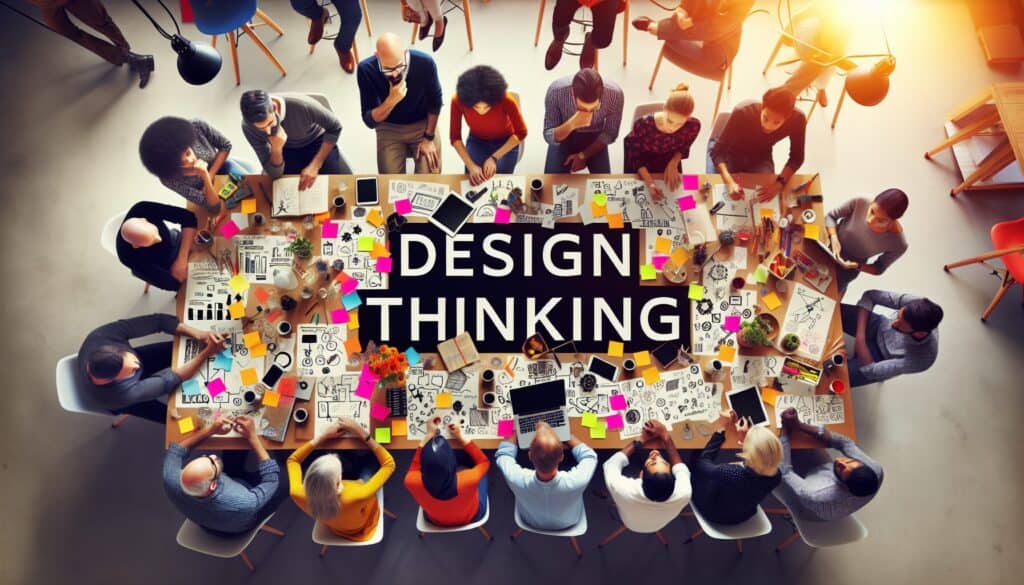A human-centered, iterative approach to problem-solving and innovation that focuses on understanding user needs, challenging assumptions, redefining problems, and creating innovative solutions to prototype and test.
- Methodologies: Engineering, Quality
Design Thinking

Design Thinking
- Cross-Functional Collaboration, Design Process, Design Thinking, Human-Centered Design, Ideation, Innovation, Prototyping, User experience (UX), User-Centered Design
Objective:
How it’s used:
- Typically involves five phases: Empathize (understand users), Define (frame the problem), Ideate (brainstorm solutions), Prototype (create tangible representations), and Test (get user feedback). These phases are iterative and non-linear.
Pros
- Focuses deeply on user needs leading to more desirable solutions; Encourages creativity and innovation; Reduces risk by testing ideas early and often; Promotes collaboration among multidisciplinary teams.
Cons
- Can be time-consuming and may not always lead to a clear-cut solution quickly; Requires a mindset shift and can be challenging to implement in rigid organizational cultures; Success depends on the team's ability to empathize and iterate effectively.
Categories:
- Customers & Marketing, Ideation, Problem Solving, Product Design
Best for:
- Solving complex, ill-defined problems by focusing on user needs and rapidly iterating on potential solutions.
Design Thinking is utilized across a wide range of industries, including technology, healthcare, education, and consumer goods, owing to its adaptability in solving multifaceted issues through a user-centric approach. Organizations often initiate this methodology during the early stages of product development or when rethinking existing services, facilitating collaboration among diverse stakeholders such as designers, engineers, marketers, and end-users. Each phase of Design Thinking can be employed recursively, allowing teams to revisit previous steps based on feedback and new findings, which enhances the depth of understanding regarding user experiences. For example, a tech company might employ Design Thinking to develop a new app, starting with extensive user interviews to gain insights into user habits before defining the core problems that the app aims to solve. Workshops during the Ideate phase can unleash creativity, leading to a plethora of innovative solutions, from simple feature modifications to entirely new functionalities. Once prototypes are produced, iterative testing not only validates concepts but also uncovers unforeseen challenges or opportunities, allowing for refinement that aligns with actual user needs. By fostering collaboration across disciplines, from engineering to marketing, organizations cultivate a culture that embraces experimentation and iterative learning, thereby increasing the likelihood of market acceptance and success. Users play a pivotal part in this process; their feedback is paramount, making the final product more aligned with their preferences while significantly reducing the risk associated with new launches.
Key steps of this methodology
- Conduct user interviews and observations.
- Identify key user needs and pain points.
- Articulate a clear problem statement.
- Brainstorm a wide range of potential solutions.
- Select promising ideas for further development.
- Create low-fidelity prototypes for concepts.
- Gather user feedback on prototypes.
- Refine solutions based on feedback.
- Iterate on prototypes and retest.
Pro Tips
- Engage stakeholders early and encourage their involvement throughout the design process for diverse perspectives and greater buy-in.
- Utilize collaborative tools that facilitate real-time feedback and iterations, ensuring efficient transitions between phases.
- Incorporate storytelling techniques in presentations to convey design concepts effectively and foster emotional connections with users.
To read and compare several methodologies, we recommend the
> Extensive Methodologies Repository <
together with the 400+ other methodologies.
Your comments on this methodology or additional info are welcome on the comment section below ↓ , so as any engineering-related ideas or links.
Historical Context
1949
1950
1950
1960
1960
1960
1960
1940
1950
1950
1958
1960
1960
1960
1960
(if date is unknown or not relevant, e.g. "fluid mechanics", a rounded estimation of its notable emergence is provided)















Related Posts
METS to Calories Calculator
Meta-Analysis
Message Mapping
Mental Model Diagrams
Maximum Acceptable Pushing and Pulling Forces
Material Requirements Planning (MRP)